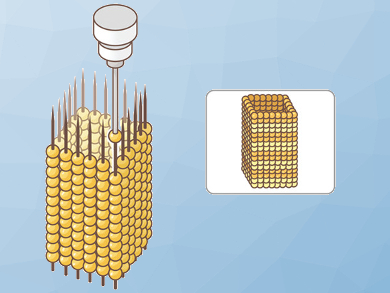An intact trachea is necessary to keep the airways open and prevent suffocation. When large parts of a trachea need to be removed surgically, replacement can be tricky: Synthetic prostheses, foreign transplants, and using a patient’s own cells grown on scaffolds can all cause different, possibly life-threatening complications. Using a patient’s own cells without a scaffold could prevent many of these problems, but requires improvements in scaffold‐free tissue‐engineering.
Takeshi Nagayasu, Nagasaki University, Japan, and colleagues have used a bio‐3D printing system which uses needles to arrange spheroids made from cells and create complex 3D structures (pictured left). The method is called “kenzan”, after the needle plates used to arrange flowers in the Japanese art ikebana. The team prepared spheroids from different human cell types which form cartilage and fibrous tissue. Each spheroid was seeded with about 20,000 cells. They then arranged these spheroids on the needles using a bio-3D printer to recreate the ringed, layered structure of a trachea (pictured right).
The cells were then cultured in a bioreactor for one week, and the resulting trachea-like tubes implanted into rats. The team found that the structures generated by this technique develop sufficient mechanical strength within a month. According to the researchers, the engineered structures could represent a significant step toward the clinical application of bioengineered organs.
- Replacement of Rat Tracheas by Layered, Trachea-Like, Scaffold-Free Structures of Human Cells Using a Bio-3D Printing System,
Ryusuke Machino, Keitaro Matsumoto, Daisuke Taniguchi, Tomoshi Tsuchiya, Yosuke Takeoka, Yasuaki Taura, Masaaki Moriyama, Tomoyuki Tetsuo, Shosaburo Oyama, Katsunori Takagi, Takuro Miyazaki, Go Hatachi, Ryoichiro Doi, Koichiro Shimoyama, Naoto Matsuo, Naoya Yamasaki, Koichi Nakayama, Takeshi Nagayasu,
Adv. Healthcare Mater. 2019.
https://doi.org/10.1002/adhm.201800983



